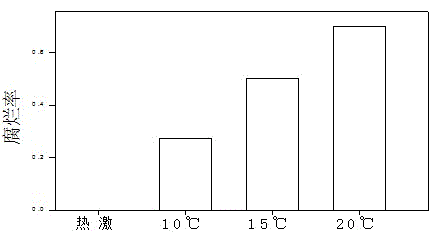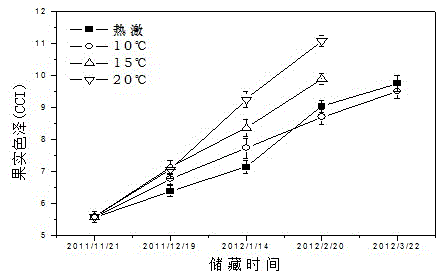Fruit storage method of ponkan
A fruit and ponkan technology applied in the field of fruit storage to achieve low cost, low equipment requirements, and resistance to pathogenic bacteria
- Summary
- Abstract
- Description
- Claims
- Application Information
AI Technical Summary
Problems solved by technology
Method used
Image
Examples
Embodiment 1
[0016] The fruit materials used in the experiment were collected in Zhejiang Province on November 21, 2011. After harvesting, the fruits with uniform size, no mechanical damage, and no pests and diseases were selected and divided into 4 groups. The first group: directly placed at 10°C for low-temperature storage (treatment A) ; The second group: directly stored at 15°C (treatment B); the third group: directly placed at 20°C for storage (treatment C); the fourth group: the ponkan fruit was soaked in warm water at 55°C for heat shock treatment After 20S of resistance training, the fruits were dried with absorbent paper and stored at 10°C (treatment D).
[0017] During the storage period, the fruit rot rate (60 fruits) was counted monthly. Three repetitions were set up for each experimental group.
[0018] Testing standard:
[0019] ①Fruit rot rate: the percentage of rotten fruits in the inspected fruits.
[0020] ②Measurement of fruit color difference: The color of fruit peel...
Embodiment 2
[0023] The experimental results showed that among the four treatments A, B, C and D, compared with the other three treatments, treatment D could significantly reduce the fruit rot rate of Ponkan fruit, inhibit the activity of pathogenic bacteria, and delay the ripening and senescence process of Ponkan fruit. Especially when the heat shock treatment (treatment D) was stored until the fourth month, no fruit rot was found; at the same time, the results showed that in the fourth month of storage of ponkans, the fruit rot rates of treatments A, B and C were 27.27% and 50% respectively , 70%. It can be seen that the rotten rate of ponkan fruit can be significantly reduced by combining heat shock treatment at a lower temperature of 10°C. In the fourth month of storage, under the same storage condition of 10℃, heat shock treatment can reduce the fruit rot rate by 27.27%, so the effect of heat shock treatment on inhibiting the fruit rot rate of stored ponkan is extremely significant. ...
Embodiment 3
[0026] Unsuitable storage temperature during fruit storage often causes abnormal fruit respiration and metabolism, resulting in excessive consumption of fruit sugar and acid substances, resulting in poor flavor and quality of the fruit. An important indicator of the quality decline of ponkan fruit during storage and transportation is the decrease of soluble solids (TSS), which leads to a decline in the quality of edible flavor. The results of the study showed that the TSS of ponkan fruit stored at 20°C for three months showed an increasing trend during the experiment, and the total TSS increased by about 10% in the third month of the experiment. The TSS of ponkan was basically stable under the storage condition of 15℃. Under the storage condition of 10°C, the TSS of ponkan fruit showed a downward trend, but heat shock treatment could significantly delay the degree and rate of TSS decline under the same storage condition of 10°C (see image 3 ).
PUM
 Login to View More
Login to View More Abstract
Description
Claims
Application Information
 Login to View More
Login to View More - R&D
- Intellectual Property
- Life Sciences
- Materials
- Tech Scout
- Unparalleled Data Quality
- Higher Quality Content
- 60% Fewer Hallucinations
Browse by: Latest US Patents, China's latest patents, Technical Efficacy Thesaurus, Application Domain, Technology Topic, Popular Technical Reports.
© 2025 PatSnap. All rights reserved.Legal|Privacy policy|Modern Slavery Act Transparency Statement|Sitemap|About US| Contact US: help@patsnap.com



